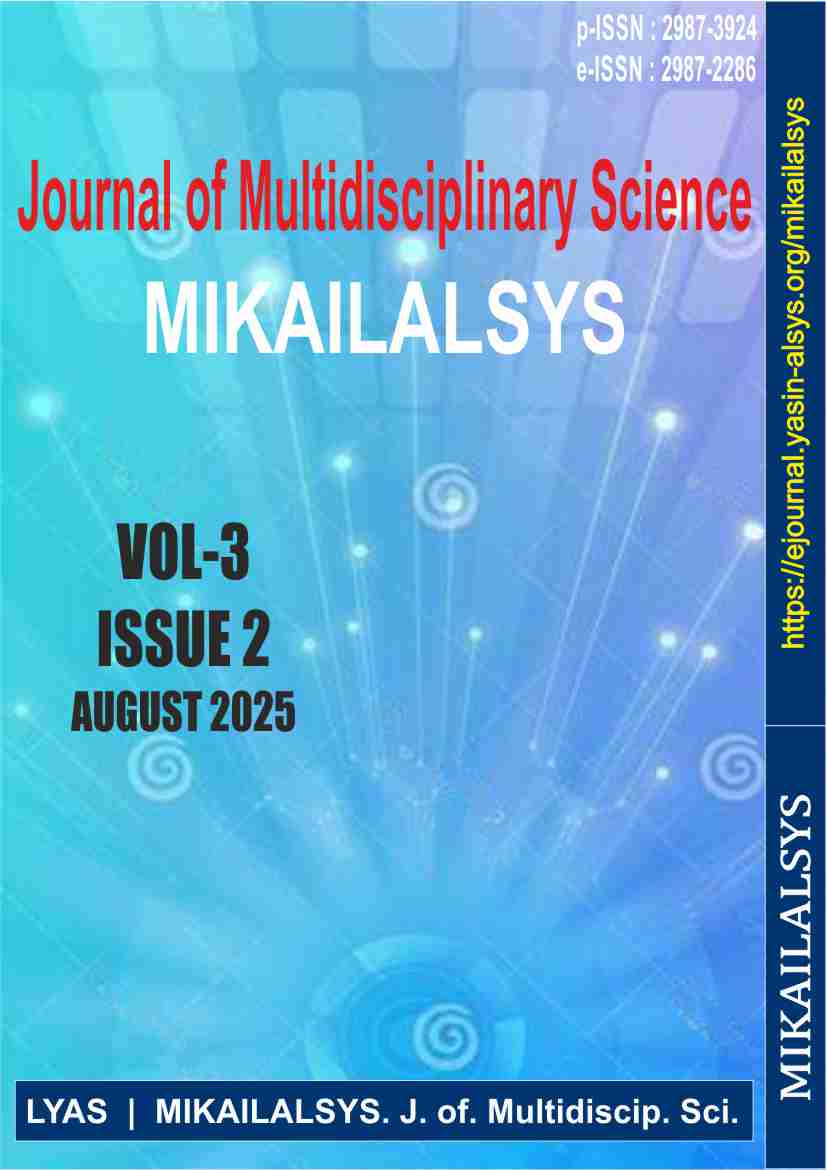A Review: The Role of Electrical Resistivity in Groundwater Exploration and Management

Main Article Content
Abstract
The review paper explores the use of electrical resistivity techniques to explore and manage groundwater, providing vital insights into aquifer properties and the behavior of groundwater. It delves into the principles and applications, limitations, and potential future developments. Groundwater is a very important water source for sustainable development, especially in dry areas thereby making effective groundwater exploration essential. Geophysical techniques like vertical electrical resistivity soundings (VES) and electrical resistivity tomography (ERT) are some of the methods used in analyzing subsurface characteristics and the behavior of aquifers. These methods allow the identification of hydrogeological parameters such as water saturation, porosity, and aquifer boundaries. This article further explores how instrumentation advancements, machine learning, and integrated approaches also improve accuracy in subsurface imaging despite geological complexities and interpretation ambiguities. The resistivity methods have proven effective in coastal aquifers, detecting saltwater intrusion, and monitoring groundwater quality.




Citation Metrics:


Downloads
Article Details

Authors retain copyright and grant the journal right of first publication with the work simultaneously licensed under a Creative Commons Attribution-NonCommercial-ShareAlike 4.0 International License that allows others to share the work with an acknowledgement of the work's authorship and initial publication in this journal.
References
Abotalib, A. Z., Heggy, E., El Bastawesy, M., Ismail, E., Gad, A., & Attwa, M. (2021). Groundwater mounding: A diagnostic feature for mapping aquifer connectivity in hyper-arid deserts. Science of The Total Environment, 801: 149760.
Abu-Zeid, N., Botteon, D., Cocco, G., & Santarato, G. (2005). Non-invasive characterization of ancient foundations in Venice using the electrical resistivity imaging technique. NDT & E International, 39(1): 67–75.
Ahmed, A., and Alam, M. Z. (2024). Application of Electrical Resistivity Tomography in Geotechnical and Geoenvironmental Engineering Aspects. Geotechnics, 4(2): 399–414.
Akpan, A. E., Andráš, P., Ekanem, A. M., Eldosouky, A. M., Alarifi, S. S., Thomas, J. E., Ebong, E. D., Abdelrahman, K., Fnais, M. S., Ekwok, S. E., George, N. J., & Ben, U. C. (2023). Direct Detection of Groundwater Accumulation Zones in Saprock Aquifers in Tectono-Thermal Environments. Water, 15(22): 3946.
Al-Fares, M. (2014). Limitations of electrical resistivity tomography in complex geological settings. Environmental Monitoring and Assessment, 186(10): 6767-6780.
Aranguren-Díaz, C., Mena, J., and Pacheco, J. (2024). Hydrogeochemical studies in groundwater management. Hydrogeology Journal, 32(1): 45-58.
Asfahani, J., Aretouyap, Z., and George, N. (2023). Hydraulic characterization of the Adamawa-Cameroon aquifer using the inverse slope method. Water Practice and Technology, 23:334-344
Auken, E., and Christiansen, A. V. (2004). Layered and laterally constrained 2D inversion of resistivity data. Geophysics, 69(3): 752–761.
Baas, A. C. W. (2007). Challenges in aeolian geomorphology: Investigating aeolian streamers. Geomorphology, 93(1–2): 3–16.
Batayneh, A. T. (2006). Use of electrical resistivity methods for detecting subsurface fresh and saline water and delineating their interfacial configuration: a case study of the eastern Dead Sea coastal aquifers, Jordan. Hydrogeology Journal, 14(7): 1277–1283.
Benabdelouahab, S., Casas Ponsati, A., Himi, M., Stitou El Messari, J. E., & Salhi, A. (2019). Geoelectrical investigations for aquifer characterization and geoenvironmental assessment in northern Morocco. Environmental Earth Sciences, 78(6): 245-257
Beres, M., Luetscher, M., & Olivier, R. (2001). Integration of ground-penetrating radar and microgravimetric methods to map shallow caves. Journal of Applied Geophysics, 46(4): 249–262.
Briški, M., Borović, S., Kosović, I., & Stroj, A. (2020). Characterization of Aquifers in Metamorphic Rocks by Combined Use of Electrical Resistivity Tomography and Monitoring of Spring Hydrodynamics. Geosciences, 10(4): 137.
Costall, A., McKenzie, J., & Smith, D. (2018). Electrical resistivity imaging for coastal hydrogeology: A review. Coastal Engineering, 134: 1-12.
Carbonel, D., Sasowsky, I., Roqué, C., Mccalpin, J. P., Zarroca, M., Linares, R., Gutiérrez, F., Rodríguez, V., & Guerrero, J. (2013). Evaluation of trenching, ground penetrating radar (GPR), and electrical resistivity tomography (ERT) for sinkhole characterization. Earth Surface Processes and Landforms, 39(2): 214–227.
Chambers, J. E., Meldrum, P. I., Wilkinson, P. B., Ward, W., Jackson, C., Matthews, B., Joel, P., Kuras, O., Bai, L., Uhlemann, S., & Gunn, D. (2015). Spatial monitoring of groundwater drawdown and rebound associated with quarry dewatering using automated time-lapse electrical resistivity tomography and distribution-guided clustering. Engineering Geology, 193: 412–420.
Cosoli, G., Revel, G. M., Tittarelli, F., Chiariotti, P., and Mobili, A. (2020). Electrical Resistivity and Electrical Impedance Measurement in Mortar and Concrete Elements: A Systematic Review. Applied Sciences, 10(24): 9152.
Drahor, M., Kovalchuk, A., & Gromov, A. (2006). Applications of electrical resistivity tomography in environmental studies. Environmental Geology, 50(4): 607-617.
Ekanem, A. M., Nathaniel, E. U., George, N. J., & Thomas, J. E. (2019). Empirical Relations Between Aquifer Geohydraulic–Geoelectric Properties Derived from Surficial Resistivity Measurements in Parts of Akwa Ibom State, Southern Nigeria. Natural Resources Research, 29(4): 2635–2646.
Elbeih, S. F. (2014). An overview of integrated remote sensing and GIS for groundwater mapping in Egypt. Ain Shams Engineering Journal, 6(1): 1–15.
Gao, J., & Liu, Y. (2001). Applications of remote sensing, GIS, and GPS in glaciology: a review. Progress in Physical Geography: Earth and Environment, 25(4): 520–540.
Gottschalk, I., Cannia, J., Asch, T., Abraham, J., & Knight, R. (2020). Using an airborne electromagnetic method to map saltwater intrusion in the northern Salinas Valley, California. Geophysics, 85(4): 119–131.
Hassan, W. H., Ghanim, A. A. J., Ritsema, C., Nile, B. K., Mahdi, F. A., Riksen, M., Mahdi, K., & Adham, A. (2023). Effect of Artificial (Pond) Recharge on the Salinity and Groundwater Level in the Al-Dibdibba Aquifer in Iraq Using Treated Wastewater. Water, 15(4): 695.
Herring, T., Lewkowicz, A. G., Hauck, C., Hilbich, C., Farzamian, M., Oldenborger, G. A., Scandroglio, R., Calmels, F., Mollaret, C., & Uhlemann, S. (2023). Best practices for using electrical resistivity tomography to investigate permafrost. Permafrost and Periglacial Processes, 34(4): 494–512.
Himi, M., Tapias, J., Benabdelouahab, S., Salhi, A., Rivero, L., Elgettafi, M., El Mandour, A., Stitou, J., & Casas, A. (2016). Geophysical characterization of saltwater intrusion in a coastal aquifer: The case of the Martil-Alila plain (North Morocco). Journal of African Earth Sciences: 126, 136–147.
Hung, Y. C., Lin, C. P., and Chou, H. S. (2020). Appraisal of the Spatial Resolution of 2D Electrical Resistivity Tomography for Geotechnical Investigation. Applied Sciences, 10(12): 4394.
Jeong, J., Cho, Y., Kim, A., Roh, H., & Shin, Y.-S. (2018, May 1). Complex Urban LiDAR Data Set.
Jessell, M., Scalzo, R., Guo, J., Cripps, E., Pirot, G., Li, Y., Lindsay, M., Ogarko, V., and Giraud, J. (2022). Into the Noddyverse: a massive data store of 3D geological models for machine learning and inversion applications. Earth System Science Data, 14(1): 381–392.
Jha, M. K., Peiffer, S., Chowdhury, A., and Chowdary, V. M. (2006). Groundwater management and development by integrated remote sensing and geographic information systems: prospects and constraints. Water Resources Management, 21(2): 427–467.
Kalinski, R., & Kelly, W. (1993). Estimating Water Content of Soils from Electrical Resistivity. Geotechnical Testing Journal, 16(3): 323–329.
Kayode, J. S., Arifin, M. H., Mansor, M. I., Abdul Malek, N. N., Musa, R. C., Shahri, S., Izehar, N. H., & Umor, M. R. (2023). Hydrogeophysical modeling of the groundwater aquifer units under climate variability in parts of Peninsular Malaysia: A case study of the climate-water nexus approach to sustainability. Heliyon, 9(3): e13710.
Kibria, G., & Hossain, M. S. (2012). Investigation of Geotechnical Parameters Affecting Electrical Resistivity of Compacted Clays. Journal of Geotechnical and Geoenvironmental Engineering, 138(12): 1520–1529.
Koch, K., Bonell, M., Wenninger, J., & Uhlenbrook, S. (2009). Joint interpretation of hydrological and geophysical data: electrical resistivity tomography results from a process hydrological research site in the Black Forest Mountains, Germany. Hydrological Processes, 23(10): 1501–1513.
Kumar, D., Kumar, S., & Singh, S. K. (2014). Electrical resistivity methods for groundwater exploration: A review of techniques and applications. Groundwater for Sustainable Development, 2(1): 1–10.
Kumar, R., Kumaravelan, R., & Rajeshkumar, S. (2012). Advances in electrical resistivity techniques for subsurface investigations: Implications for environmental monitoring and assessment. Environmental Monitoring and Assessment, 184(11): 6747–6761.
Oghale, Lawrence. O., and Arekumo ThankGod. 2023. “Using the Electrical Resistivity Method to Assess Groundwater Iron Concentration in Otuoke and Environs (Nigeria).”. Journal of Geography, Environment and Earth Science International 27 (11):147-52. https://doi.org/10.9734/jgeesi/2023/v27i11731.
Find the perfect home for your research! If this journal isn't the right fit, don't worry—we offer a wide range of journals covering diverse fields of study. Explore our other journals to discover the ideal platform for your work and maximize its impact. Browse now and take the next step in publishing your research:
| HOME | Yasin | AlSys | Anwarul | Masaliq | Arzusin | Tsaqofah | Ahkam | AlDyas | Mikailalsys | Edumalsys | Alsystech | AJSTEA | AJECEE | AJISD | IJHESS | IJEMT | IJECS | MJMS | MJAEI | AMJSAI | AJBMBR | AJSTM | AJCMPR | AJMSPHR | KIJST | KIJEIT | KIJAHRS |















